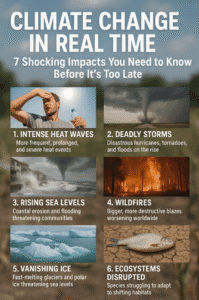Climate Change in Real Time: 7 Shocking Impacts You Need to Know Before It’s Too Late
Climate change is no longer a distant threat but a reality reshaping our world, from vanishing glaciers to collapsing ecosystems. Global temperatures have risen dangerously, intensifying heatwaves, shrinking freshwater sources, and fueling catastrophic events like wildfires and floods. Oceans, once natural carbon sinks, are turning acidic, devastating marine life and coastal economies. Biodiversity is collapsing at an alarming rate, while polluted air and climate-driven displacement worsen global health and inequality.
Erratic weather patterns threaten food and water security, deepening hunger and malnutrition. Yet, hope remains in renewable energy growth, nature restoration, and emerging climate policies. The future demands urgent, collective action—our choices today will decide tomorrow’s livability.

Climate Change in Real Time: 7 Shocking Impacts You Need to Know Before It’s Too Late
Climate change has shifted from a distant warning to an unfolding reality, reshaping ecosystems, communities, and lives. The Earth’s story is now punctuated by irreversible shifts—glaciers retreating, oceans warming, and species vanishing. Here’s how our world is transforming and what it means for our future.
- The Thermostat of the Planet is Broken
Before: A stable climate supported predictable seasons, with winter chills and summer rains aligning with historical patterns.
After: The global average temperature has risen by 1.1°C since the preindustrial era, shortening winters and intensifying heatwaves. In 2023, India recorded its hottest February in 122 years, while Europe faced deadly summer temperatures exceeding 40°C. Scientists warn of a potential 4°C rise by 2100—a scenario that would render parts of the globe uninhabitable.
Why It Matters: Longer, fiercer heatwaves strain health systems, reduce crop yields, and amplify energy demands. Delhi’s 49°C days and Pakistan’s 2022 heat-induced floods are harbingers of a “new normal.”
- Vanishing Ice: The Cryosphere in Crisis
Before: Glaciers like Argentina’s Perito Moreno expanded annually, symbolizing nature’s endurance.
After: The Arctic is warming four times faster than the global average, with Greenland losing 30 million tons of ice per hour. By 2050, the Himalayas could lose a third of their ice, jeopardizing freshwater for 2 billion people. Tuvalu, a Pacific island nation, is preparing for existential threats as rising seas contaminate groundwater and erode coastlines.
Human Impact: Indigenous communities in Alaska and the Andes face cultural disintegration as ice melt disrupts traditions tied to frozen landscapes.
- Oceans: From Blue Lungs to Acidic Hotspots
Before: Oceans absorbed 30% of CO2 emissions, mitigating early warming. Coral reefs thrived, supporting 25% of marine species.
After: Marine heatwaves have doubled since the 1980s. Australia’s Great Barrier Reef has lost half its coral since 2016 due to bleaching. Acidification from absorbed CO2 threatens shellfish and plankton—the base of marine food chains.
Ripple Effect: Coastal economies in Southeast Asia and Africa face collapsing fisheries, while stronger hurricanes, fueled by warmer waters, devastate coastal cities.
- Silent Forests, Empty Skies: The Biodiversity Collapse
Before: Earth’s biodiversity thrived, with species adapting gradually to natural changes.
After: Scientists warn we’re in the sixth mass extinction. The snow leopard, clinging to life in the Himalayas, symbolizes the crisis—poaching and habitat loss now compounded by melting ice. Insects, vital for pollination, are declining at 1-2% annually, risking food security.
Hidden Loss: Each extinct species unravels ecosystems. Bees’ decline alone threatens 75% of global crops.
- Air Quality: An Invisible Killer
Before: Pollution was localized, often mitigated by weather.
After: Climate change traps pollutants, creating year-round smog in cities like Delhi and Lahore. In 2023, 90% of urban populations breathed air exceeding WHO safety limits. Wildfire smoke, laden with PM2.5, now circles the globe—Canada’s 2023 fires polluted skies as far as Europe.
Health Toll: Respiratory illnesses, heart disease, and cognitive decline are rising. Children in polluted regions face lifelong health deficits.
- Displacement: Climate Refugees on the Move
Before: Migration was driven by conflict or economics.
After: Over 20 million annual displacements since 2008 are linked to climate disasters. In Bangladesh, saltwater intrusion has forced farmers to cities; in Somalia, droughts exacerbate conflict over dwindling resources. By 2050, 216 million could be displaced internally, predicts the World Bank.
The Inequality: Low-income nations, contributing least to emissions, bear the brunt.
- Food and Water: Scarcity in a Warming World
Before: Stable growing seasons ensured reliable harvests.
After: Erratic monsoons and droughts disrupt agriculture. India’s 2022 wheat harvest fell 15% after a heatwave, worsening global shortages. Meanwhile, warming expands pests like locusts, which devastated East African crops in 2020.
Hidden Hunger: Nutrient-rich crops like rice and wheat lose protein and zinc as CO2 levels rise, deepening malnutrition.
The Path Ahead: Solutions Within Reach
While the crisis is dire, humanity’s response offers hope:
- Renewables Revolution: Solar and wind now outprice fossil fuels in most nations. In 2023, renewables generated 30% of global electricity.
- Nature Restoration: Kenya’s mangrove replanting shields coasts and absorbs CO2. The EU’s rewilding initiatives aim to restore 20% of land and sea by 2030.
- Policy Momentum: The 2023 UN climate summit solidified loss-and-damage funds for vulnerable nations, though enforcement remains critical.
What You Can Do
- Advocate: Support policies for renewable energy and conservation.
- Consume Wisely: Reduce meat intake, avoid food waste, and choose sustainable brands.
- Amplify Voices: Elevate frontline communities in climate dialogues.
The Earth’s “before and after” story is still being written. While some changes are locked in, collective action can avert the worst—if we act with urgency, empathy, and innovation. The time to redefine our future is now.
You must be logged in to post a comment.